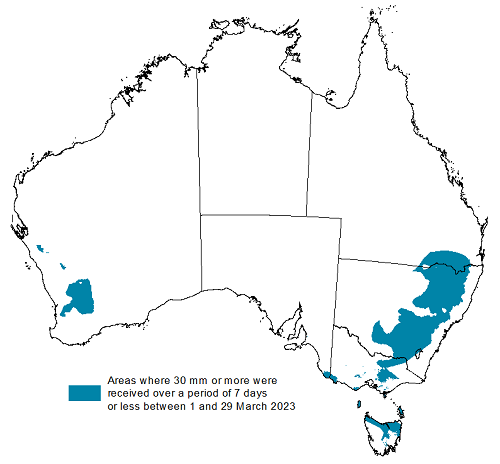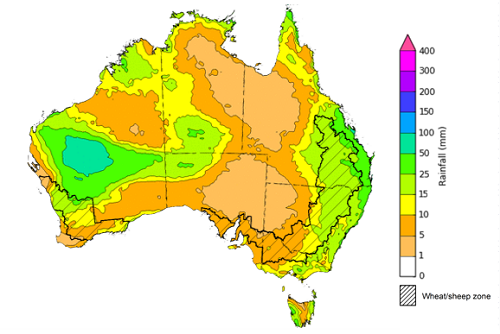Key issues
- For the week ending 29 March 2023, a number of surface low pressure troughs combined with tropical moisture to form severe thunderstorms that resulted in heavy rainfall stretching from the Pilbara through central Australia and towards southeast Australia. Cold fronts reinforced cool conditions in the south with patchy showers, gusty winds and thunderstorms across the east coast, including Queensland, New South Wales and Victoria, leading to flash floodings.
- Weekly rainfall totals of between 25 and 100 millimetres were recorded across the Pilbara, northern Gascoyne and in southwest Western Australia, tropical Northern Territory and Queensland, southeast Queensland, across much of eastern New South Wales and Victoria, central South Australia and northern Tasmania. Rainfall in excess of 100 millimetres were recorded in the Gascoyne region in Western Australia and in isolated parts of eastern New South Wales. Dry conditions were recorded elsewhere (see Section 1.1).
- In cropping regions, rainfall totals of between 15 to 150 millimetres were recorded across southeast Queensland, most of New South Wales, eastern Victoria, parts of South Australia, and much of Western Australia. Little to no rainfall was recorded across the remaining cropping regions over the past 7 days. The heavy rainfalls across cropping regions in northern New South Wales and southern Queensland will have prevented field access for harvesting of what remains of early sown summer crops. On the other hand, the rainfall will have supported vegetative growth of late sown summer crops in southern Queensland, as well as boosting soil moisture levels across eastern and western cropping regions, as the planting window for winter crops approaches (see Section 1.1).
- ABARES analysis of daily rainfall data sourced from the Bureau of Meteorology indicates that the autumn break has been achieved across cropping regions of northern, eastern and southern New South Wales, southern Queensland, parts of central and eastern Victoria, northern Tasmania and large areas of northern Western Australia (see Section 1.2).
- Over the 8-days to 6 April 2023, troughs and lows will generate widespread rainfall across western, eastern, and parts of tropical north of Australia, as well as in western and eastern Tasmania. Rainfall between 15 and 50 millimetres is expected in the Gascoyne and Pilbara regions in the Western Australia, northwest South Australia, southern Northern Territory, and in eastern Australia. Similar rainfall range will be observed in the western and eastern Tasmania as well as in parts of the coastal tropical north. Rainfall in excess of 100 millimetres is expected in the central Western Australia. Little to no rain is expected elsewhere (see Section 1.3).
- Due to unavailability of new water information from the Bureau of Meteorology, the water storage levels in the Murray-Darling Basin (MDB) have not been updated this week.
- Allocation prices in the Victorian Murray below the Barmah Choke increased from $14 on 22 March 2023 to $17 on 29 March 2023.
Climate
For the week ending 29 March 2023, a number of surface low pressure troughs combined with tropical moisture to form severe thunderstorms that resulted in heavy rainfall stretching from the Pilbara through central Australia and towards southeast Australia. Cold fronts reinforced cool conditions in the south with patchy showers, gusty winds and thunderstorms across the east coast, including Queensland, New South Wales and Victoria, leading to flash floodings. Weekly rainfall totals of between 25 and 100 millimetres were recorded across the Pilbara, northern Gascoyne and in the southwest Western Australia, tropical Northern Territory and Queensland, southeast Queensland, across much of eastern New South Wales and Victoria, central South Australia and northern Tasmania. Rainfall in excess of 100 millimetres were recorded in the Gascoyne region in Western Australia and in the isolated parts of eastern New South Wales. Dry conditions were recorded elsewhere.
In cropping regions, rainfall totals of between 15 to 150 millimetres were recorded across southeast Queensland, much of New South Wales, eastern Victoria, parts of South Australia, and much of Western Australia. Little to no rainfall was recorded across the remaining cropping regions over the past 7 days. The heavy rainfalls across cropping regions in northern New South Wales and southern Queensland will have prevented field access for harvesting of what remains of early sown summer crops. On the other hand, the rainfall will have supported vegetative growth of late sown summer crops in southern Queensland, as well as boosting soil moisture levels across eastern and western cropping regions, as the planting window for winter crops approaches.
Rainfall for the week ending 29 March 2023
Note: The rainfall analyses and associated maps utilise data contained in the Bureau of Meteorology climate database, the Australian Data Archive for Meteorology (ADAM). The analyses are initially produced automatically from real-time data with limited quality control. They are intended to provide a general overview of rainfall across Australia as quickly as possible after the observations are received. For further information go to http://www.bom.gov.au/climate/rainfall/
In southern Australia, the timing of the autumn break is an important factor for a successful pasture and crop production season. The autumn break is the first significant rainfall of the winter growing season and provides enough moisture to initiate crop and pasture germination and support early plant growth. The break generally applies to the southern pasture and cropping areas mainly in New South Wales, Victoria, South Australia, Western Australia and Tasmania — and occasionally parts of southern Queensland.
Areas likely to be influenced by the autumn break
An early autumn break can increase the length of the growing season, potentially improving production and yield. The definition of the autumn break in southern Australia varies. Pook et al. (2009) suggested an ideal break for north-western Victoria occurs during March–June when a mean fall of 25 millimetres or more is recorded over a period of 3 days or less, or when a mean fall of 30 millimetres or more is recorded over a period of 7 days or less.
It is important to remember that while the timing of the rain is important, as to whether it constitutes a break or not, it is the weather following this early break that will determine whether this is a ‘false’ break or a true early break. For example, a 30mm rainfall event in March followed by warm, dry weather may not constitute the break. However, if a similar rainfall event were to occur during April, it will likely be the break that many southern farmers have been waiting for. An early autumn break in and of itself does not guarantee a successful growing season; sufficient winter and spring rainfall is still required, particularly in areas with little to no stored soil moisture, to deliver a successful crop and pasture production season.
Southern pasture and cropping areas that have achieved 30 millimetres in any 7‐day period from 1 March to 29 March 2023
ABARES has adapted the Pook et al. (2009) autumn break definition of falls of 30 millimetres or more recorded within any 7-day period from 1 March to identify where the autumn break threshold has been achieved across southern Australia. ABARES analysis of daily rainfall data sourced from the Bureau of Meteorology indicates that the autumn break has been achieved across cropping regions of northern, eastern and southern New South Wales, southern Queensland, parts of central and eastern Victoria, northern Tasmania and large areas of northern Western Australia.
Typically, the autumn break is driven by westerly fronts moving across southern Australia and cut-off low pressure systems. This early autumn break in south-eastern Australia has been driven by a number of thunderstorms that formed mainly from tropical moisture moving south and combining with the surface troughs creating the uplifts. In Western Australia the early autumn break has been the result of surface troughs stretching south from the tropical northwest of the country.
Over the 8-days to 6 April 2023, troughs and lows will generate widespread rainfall across western, eastern, in parts of tropical north of Australia, and in western and eastern Tasmania. Easing showers are expected over coastal New South Wales and nearby ranges from the existing troughs moving eastwards towards the coast. Onshore winds will drive showers into southeast Queensland and northeast New South Wales. Humid and unstable winds will generate showers over northern tropics. In the Western Australia, a trough will continue to bring rain and storms across Pilbara and Gascoyne regions. Dry and cool conditions are expected through much of the country south as a high-pressure system moves in. Onshore winds around high-pressure system should bring a few showers to southern Australia.
Rainfall between 15 and 50 millimetres is expected in the Gascoyne and Pilbara regions in the Western Australia, northwest South Australia, southern Northern Territory, and in the eastern Queensland, New South Wales, and Victoria. Similar rainfall range will be observed in the western and eastern Tasmania as well as in parts of the coastal tropical north. Rainfall in excess of 100 millimetres is expected in the central Western Australia. Little to no rain is expected elsewhere.
Across Australian cropping regions, rainfall totals of between 15 and 25 millimetres are expected for much of Queensland and New South Wales, eastern Victoria, and much of Western Australia. Little to no rainfall is expected for the remaining cropping regions in the next eight days. If realised, the rainfall in the cropping regions is likely to result in some harvest delays for summer crops. The forecast rainfall over much of the Australian wheatbelt is likely to build soil moisture levels in the led up to the winter cropping season and also benefit pasture growth rates and availability.
Total forecast rainfall for the period 30 March to 6 April 2023
Note: This rainfall forecast is produced from computer models. As the model outputs are not altered by weather forecasters, it is important to check local forecasts and warnings issued by the Bureau of Meteorology.
Water
Water storages, water markets and water allocations - current week
The Tableau dashboard may not meet accessibility requirements. For information about the contents of these dashboards contact ABARES.
Commodities
Information on weekly price changes in agricultural commodities is now available at the Weekly commodity price update.




